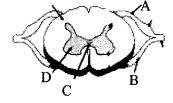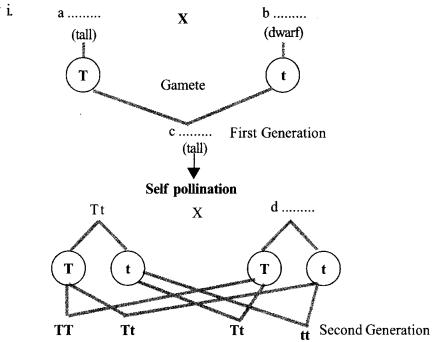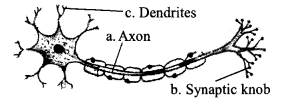Kerala SSLC Biology Previous Question Papers with Answers 2018 are part of Kerala SSLC Biology Previous Year Question Papers with Answers. Here we have given Kerala SSLC Biology Previous Question Papers with Answers 2018.
| Board | SCERT |
| Class | SSLC Class 10 |
| Subject | Biology |
| Category | Kerala SSLC Previous Question Papers |
Kerala SSLC Biology Previous Question Papers with Answers 2018 Free Download English Medium
Time Allowed: 1 1/2 Hours
Maximum Marks: 40
Instructions
- First 15 minutes is given as cool off time. This time is to be used for reading and understanding the questions.
- Answer only on the basis of instructions and questions given.
- Consider score and time while answering.
Answer any five from questions 1 to 6. Each question carries 1 score. (5 x 1 = 5)
Question 1:

What does the number ’44’ indicate in this illustration ?
Question 2:
Find out the correct pair from the following:
a. Thalamus – Maintenance of homeostasis
b. Medulla oblongata – Centre of thought, intelligence etc.
c. Cerebellum – Coordinates muscular activities
d. Cerebrum – Relaying of impulses
Question 3:
Identify the word pair relation and fill the blanks.
a. Arrangement of nucleotides : DNA profiling
b. Identifying the location of a gene in DNA: …………..
Question 4:
Which one of the following gases was not present in the atmosphere of primitive earth ?
a. Methane
b. Ammonia
c. Oxygen
d. Nitrogen
Question 5:
Choose the names of pheromones from the terms given in the box.
![]()
Question 6:
Fill the blanks in the statement.
“Three types of cone cells are present in human eye. This is due to the change in ……… in the Opsin molecule”.
Answer any six from questions 7 to 13. Each question carries 2 score. (6 x 2 = 12)
Question 7:
a. Identify the picture given.

b. What do A and B indicate ?
Question 8:
“Mucus and Cilia in the respiratory tract provide first level defense.”
a. What is the role of mucus and cilia in defense ?
b. Write an example for second level defense ?
Question 9:
List out four concepts that can be included in the pamphlet to be distributed in an awareness programme against dengue fever.
Question 10:
a. Identify the disease from the following symptoms.
- Continuous muscular contraction
- Frothy discharge from the mouth
- Clenching of the teeth
- Patient falls unconscious
b. Write the cause of this disease.
Question 11:
“Though antibiotics are effective medicines, their regular use develops immunity in pathogens against antibiotics.”
Write any two other side effects of the regular use of antibiotics.
Question 12:
“The basis of genetic engineering is the discovery of the fact that genes can be cut and joined with the help of enzymes.”
a. Name the enzyme used for cutting genes.
b. Name the enzyme used for joining the genes.
Question 13:
a. Select the statements related to the disease Haemophilia from the following:
- Structure of haemoglobin changes.
- The synthesis of proteins that help in the clotting of blood fails.
- Oxygen carrying capacity of haemoglobin decreases.
- Excess bleeding even through minor wounds.
b. Name the disease to which other statements are related.
Answer any five from questions 14 to 20. Each question carries 3 score. (5 x 3 = 15)
Question 14:
a. Identify the given diagram.

b. Name the parts labelled as A, B, C and D.
Question 15:
Match the plant hormones and their functions suitably.

Question 16:
The main concepts of two theories regarding the origin of life on earth are given. Arrange them in the following table. Write the name of theories as title.
i. Life has originated in some other planet in the universe.
ii. Changes occurred in the chemical substances in water, under specific conditions of the earth.
iii. Organic substances identified in meteors supports this theory.
iv. Life originated in the Ocean.

Question 17:
Complete the illustration of the hybridisation experiment conducted by Mendel in Pea plants.

ii. Which are the characters expressed in second generation ?
Question 18:
How do the following substances protect the plants from disease ?
a. Lignin
b. Callose
c. Cuticle
Question 19:
a. Name the factors that lead to transformation of normal cells into cancer cells.
b. Name two methods used in the treatment of cancer.
Question 20:

a. What do A, B and C indicate in the above illustration ?
b. How do conjunctiva and tears protect the eye ?
Answer any two from questions 21 to 23. Each question carries 4 score. (2 x 4 = 8)
Question 21:
Arrange columns B and C according to the items in column A.
| A | B | C |
|
|
|
Question 22:
Certain hormones released from the anterior lobe of pituitary gland are given.
- Thyroid Stimulating Hormone (TSH)
- Adreno Cortico Tropic Hormone (ACTH)
- Gonado Tropic Hormone (GTH)
a. Write the common feature of these hormones.
b. Write one function of ACTH and TSH.
c. Name two hormones secreted by the action of GTH.
Question 23:
Redraw the diagram. Name and label the parts indicated below

a. Carries impulses away from the cell body
b. Secretes neurotransmitter
c. Branches of dendrons
Answers
Answer 1:
Autosomes
Answer 2:
c. Cerebellum – Coordinates muscular ativities
Answer 3:
Gene mapping
Answer 4:
c. Oxygen
Answer 5:
Bombykol, Civetone
Answer 6:
Amino acid
Answer 7:
a. Nucleotide
b. A – Phosphate, B – Nitrogen base
Answer 8:
a. Mucus: Mucus in the trachea prevents the entry of germs into the lungs.
Cilia: The cilia in the bronchus wipe out dust that enters it.
b. Inflammatory response
Answer 9:
Phagocytosis, blood clotting, inflammatory response etc.
Answer 10:
a. Dengue fever
b. By sucking the blood of an infected person, the mosquito becomes the vector of the dengue virus. The dengue virus multi plies within the body of the mosquito.
Answer 11:
Regular use develops immunity in pathogens against antibiotics. Destroys useful bacteria in the body. Reduces the quantity of some vitamins, in the body.
Answer 12:
a. Restriction Endonuclease / Gentetic Scissors
b. Ligase/Genetic Glue
Answer 13:
a. The synthesis of proteins that help in the clotting of blood fails. Excess bleeding even through minor wounds.
b. Sickle cell aneaemia
Answer 14:
a. Spinal cord
b. A – Dorsal root B – Ventral root
C – Central canal D – Grey matter
Answer 15:
Auxin – Promoting growth of terminal buds
Gibberllin -Stimulate the breakup stored food
Ethylene – Helps in ripening of fruit
Abscisic acid – Control wilting of leaves, flowering etc.
Answer 16:
a. Panspermia theory:
- Life has originatcd in some other planet in the universe.
- Organic substances identified in meteors supports this theory.
b. Chemical evolution theory
- Changes occurred in the chemical sub stances in water under specific conditions of the earth.
- Life originated in the Ocean.
Answer 17:
i. a.TT b.tt c.Tt d.Tt
ii. Tall/TT, Tt Dwarf /tt
Answer 18:
Lignin : Provide rigidity to the cell wall.
Callose: Prevents the entry of germs which have crossed the cell wall.
Cuticle: Defends the attack of microorganisms.
Answer 19:
a. Environmental factors, smoking, radiations, virus, hereditary factors and alterations in genetic material.
b. Surgery, chemotherapy, radiation therapy.
Answer 20:
a. A – Aqueous humour, B – Vitreous humour C – The fluid filled in the chamber between the lens and the retina.
b. Conjunctiva: Secretes mucus which protects the anterior portion of the eye ball from being dry.
Tears: Clean and lubricate the anterior part of the eye ball. Lysozyme, the enzyme present in tears, destroys germs that enter the eyes.
Answer 21:
i. Cataract – Lens become opaque – Lens replacement surgery
ii. Glaucoma – Increased pressure in the eyes – Laser surgery
iii. Conjunctivitis – Infection – Hygiene
iv. Xerophthalmia – Cornea become dry and opaque – Diet containing Vitamin A
Answer 22:
a. Tropic Hormones / stimulating hormones
b. ACTE-I – Stimulate the acticity of adrenal Cortex.
TSH -Stimulate the activity of thyroid gland.
c. Testosterone oestrogen, progesterone
Answer 23:

We hope the Kerala SSLC Biology Previous Question Papers with Answers 2018 help you. If you have any query regarding Kerala SSLC Biology Previous Question Papers with Answers 2018, drop a comment below and we will get back to you at the earliest.
